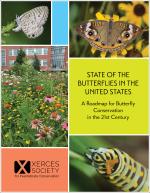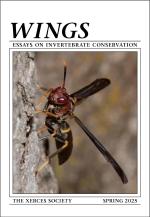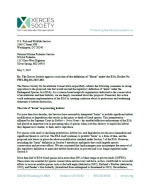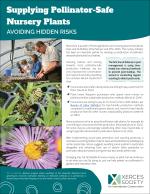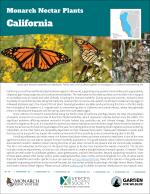As a science-based organization, the Xerces Society produces dozens of publications annually, all of which employ the best available research to guide effective conservation efforts. Our publications range from guidelines for land managers, to brochures offering overviews of key concepts related to invertebrate conservation, from books about supporting pollinators in farmland, to region-specific plant lists. We hope that whatever you are seeking—whether it's guidance on making a home or community garden pollinator-friendly, advice on developing a local pesticide reduction strategy, or detailed information on restoring habitat—you will find it here!
Find Publications
Use the search functions to sort by publication type (books, guidelines, fact sheets, etc.), location, and/or subject (agriculture, gardens, pollinators, pesticides, etc.).
Cut, color, and wear this fun mask to flutter like a butterfly! This butterfly is modeled after the beloved North American monarch butterfly (Danaus plexippus). This is an educational craft activity for kids.
Cut, color, and wear this fun mask to buzz like a bumble bee! This is an educational craft activity for kids.
Cut, color, and wear this fun mask to flutter like a butterfly! This butterfly is modeled after the Xerces blue butterfly (Glaucopsyche xerces), which is the Xerces Society's namesake. This is an educational craft activity for kids.
A Roadmap for Butterfly Conservation in the 21st Century
A study published in March 2025 showed that we are losing butterflies at a rate of 1.3% per year in the contiguous US. State of the Butterflies in the United States presents a summary of those findings, species-level information on population trends for each of seven regions, and most importantly, a roadmap for how we can recover butterflies in the places we live, work, and play.
Essays on Invertebrate Conservation
At the Xerces Society, one thing that unites all of us—staff, donors, collaborators—is a love for insects or other invertebrates. In this issue of Wings, the articles explore the natural history of two diverse and often misunderstood groups, wasps and grasshoppers, and one intriguing moth from New Zealand.
Docket No. FWS-HQ-ES-2025-003
The Xerces Society opposes rescission of the definition of “Harm” under the ESA, Docket No. FWS-HQ-ES-2025-003. We respectfully submit the following comments in strong opposition to the proposed rule that would rescind the regulatory definition of “harm” under the Endangered Species Act (ESA). If enacted, this action could undermine implementation of the ESA by creating confusion about its protections and weakening deterrents to habitat destruction.
On August 18, 2020, the Xerces Society filed a petition to list the western ridged mussel as an endangered species under the U.S. Endangered Species Act. The western ridged mussel has been lost from 43% of its historic range. In addition, sudden die offs of western ridged mussels have been observed in Oregon and Washington.
AVOIDING HIDDEN RISKS
Many producers strive to provide pollinator-safe plants, but may be unknowingly substituting other risky insecticides or using fungicides detrimental to pollinators. In this fact sheet, Xerces suggests which insecticides to avoid altogether and which to refrain from use on pollinator-attractive plants during the last two weeks before sale.
This regional list of monarch nectar plants is geared toward gardeners, landscape designers, and land managers who are implementing small- to large-scale monarch restoration projects in California.
A Comparative Overview
This fact sheet is intended to be a quick reference to help you select and use organically-approved pesticides with the least impact on bees and other beneficial insects.




